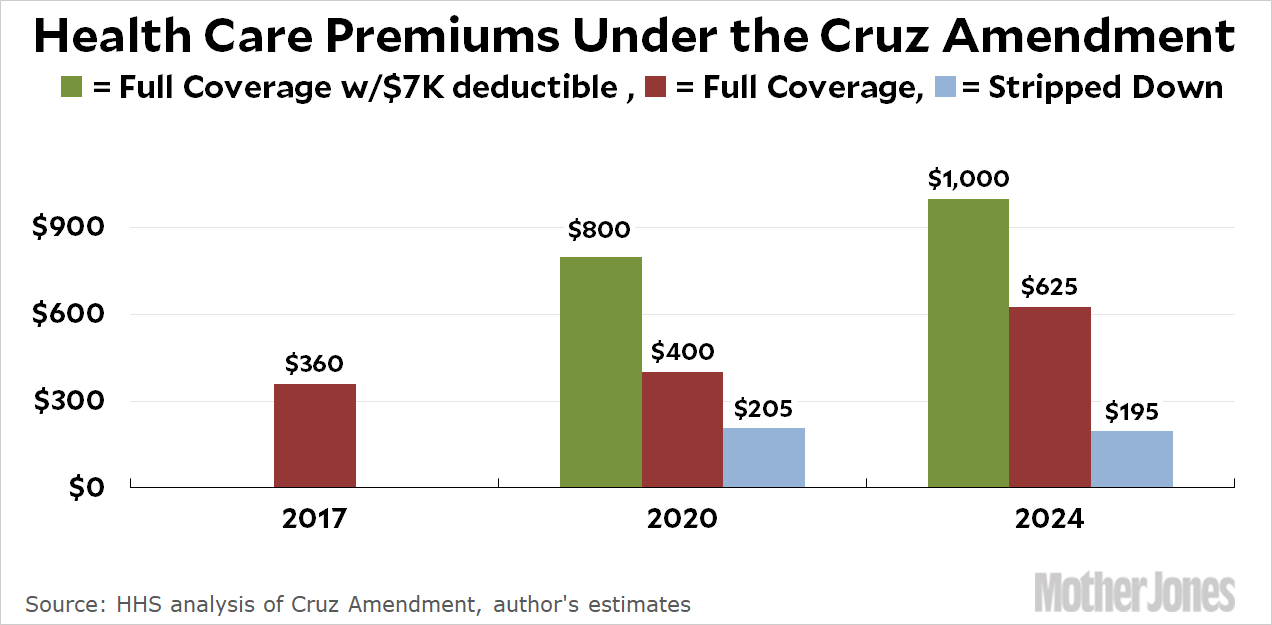Remember the Cruz Amendment? It’s probably as dead as the rest of Trumpcare, but HHS has released an analysis anyway. Long story short, they project that enrollment will go up and average premiums will go down compared to Obamacare.
And that’s actually possible. The Cruz Amendment would allow insurers to offer both full-coverage plans (i.e., ACA compliant) and stripped-down plans. The full-coverage plans would be expensive and would appeal to the old and sick. The stripped-down plans would be cheap and would appeal to the young and healthy. It’s entirely possible that the gain of healthy people would be greater than the loss of sick people, and that a pool with more healthy people would indeed have lower average premiums.
Of course, this is all sleight of hand. Averages are meaningless here. What we want to know is how much premiums will skyrocket for sick people, who have no choice but to buy the full-coverage plans. Here is the HHS estimate:¹

These numbers are derived from a “proprietary elasticity estimate,” so I have no idea how they’re calculated. In any case, HHS estimates that both the young and the healthy will flee the full-coverage plans, meaning that nearly half the pool for those plans will be the old and the sick. Given this, it’s hard to believe that average premiums in this pool will rise from $360 to only $625. That seems…optimistic. The trick, it turns out, is that HHS is assuming a $12,000 deductible per person (!). That would certainly help to keep premiums down. As a public service, then, I’ve added the green bars, which is my estimate of what these premiums would be if we ratcheted that back down to Obamacare’s more defensible $7,000 deductible. Comparing apples to apples, premiums actually triple. At least.
Additionally, HHS projects that by 2024 about half of all customers will still choose to enroll in a full-coverage plan, which also strikes me as a wee bit optimistic. But who knows? Since most people would still be protected by Obamacare’s subsidies, which go up as premiums go up, maybe lots of people really would stay in full-coverage plans, even with the sky-high deductibles. Of course, that would cost the government a lot of money, and sure enough, HHS projects that by 2024 the Cruz Amendment would cost the feds an extra $10 billion per year.
If Republicans allow CBO to finish its score of the Cruz Amendment, I guess we’ll find out if they agree. In the meantime, take this with a big grain of salt. HHS is not exactly a neutral party in this.
BY THE WAY: If you decide to look at the HHS analysis, you’ll notice that the first half is all estimates of the Cruz Amendment assuming a single risk pool. You should ignore this and move straight to the second half, which assumes two risk pools. This is practically the whole point of the Cruz Amendment, so I have no idea why they even bothered with estimates for a single risk pool.
¹HHS actually provides both low and high estimates. I averaged them to produce a single number.

















